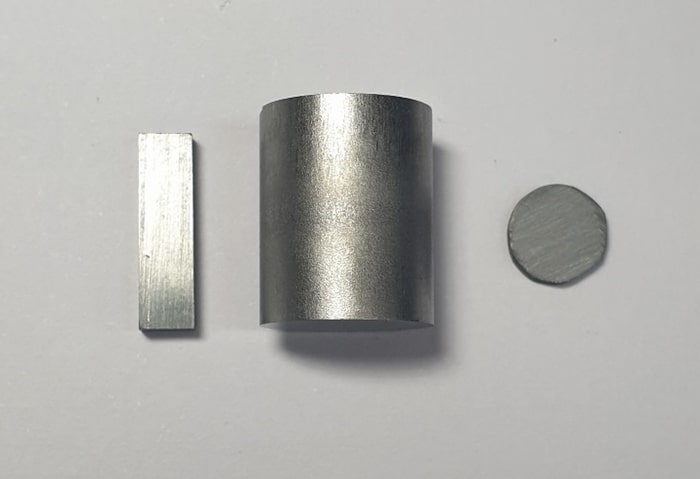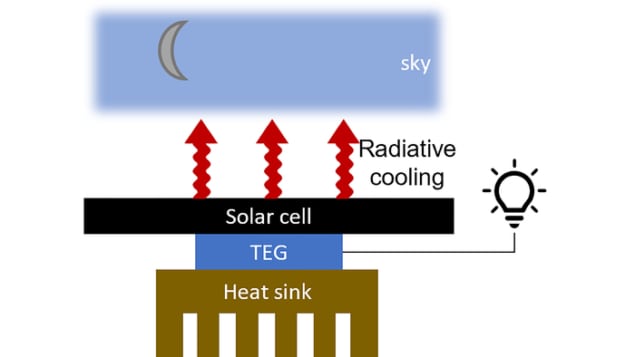Solar cell keeps going after sunset
27 Apr 2022 Isabelle Dumé
A new type of photovoltaic cell continues working after sunset thanks to an additional generator that harvests electricity from the temperature difference between the cell and its surroundings. The combined device can generate 50 mW or more of power per square metre at night while providing additional power during the day, and its developers say that it could provide a continuous source of renewable energy for people without access to the electrical grid.
When the Sun is shining, conventional photovoltaic (PV) cells absorb energy over a wide range of wavelengths. At night, the cells lose heat to their surroundings, leaving them several degrees cooler than the ambient air due to radiative cooling.
Thermoelectric effect
The new device uses this difference in temperatures to generate a voltage and current via the thermoelectric effect. Here, a temperature gradient across a solid material containing free charge carriers (electrons and holes) produces a voltage as the carriers migrate from the hot side of the material to the cold side. The strength of this thermoelectric effect is characterized by its thermopower, or Seebeck coefficient, which is the ratio of the voltage difference to the temperature difference across a material.
The new device, which was developed by Shanhui Fan and colleagues at Stanford University in the US, can generate up to 100 mW/m2 of power depending on location and weather conditions. It also has an open-circuit voltage of 100 mV, which is orders of magnitude higher than previous demonstrations. “This improvement comes thanks to improved thermal engineering, especially in terms of enhancing the thermal coupling between the solar cells and the thermoelectric module,” Fan tells Physics World.
Simple and inexpensive setup
The researchers designed their device around a commercial SunPower C-60 monocrystalline silicon solar cell with a surface area of 153 cm2. To improve thermal conduction across the cell’s surface and enable effective heat transfer to and from the smaller thermoelectric generator (TEG) module, they placed an aluminium sheet underneath the cell. They then connected the underside of the TEG to a base support and a standard heat sink repurposed from a personal computer. This configuration, together with silicone thermal grease applied at each component interface, facilitates efficient heat transfer across the device.
To minimize so-called parasitic heat flow due to inherent inefficiencies in the system, the researchers enclosed the PV cell within a chamber made from polystyrene sheets, with an opening at the bottom for connecting the heat sink. They then covered the top of the chamber with a low-density polyethylene (LDPE) film, which is transparent in both the visible and the mid-infrared wavelength range.READ MORE

Fan and colleagues tested their device on a rooftop at Stanford, taking measurements on 10–13 October 2021. During this period the sky turned from clear to cloudy. They measured the power of the TEG and the PV cell, as well as the ambient temperature and the temperatures of the PV panel and heat sink. They also measured the electrical power the cell generated using a maximum power point tracking algorithm.
The set-up is simple and inexpensive and could, in principle, be incorporated into existing solar cells, says team member Sid Assawaworrarit. Since none of the components in the device were specifically engineered for this purpose, there is room for improvement, he adds.
Off-grid applications
According to the researchers, the power generated could be used for night-time standby lighting and power in off-grid and mini-grid applications (an area in which PV cell installations are becoming more popular); for charging low-power devices; or for providing power to sensors in remote locations without the need for battery storage. Lighting, for example, would require a PV cell with an area of 20 m2. Thanks to the long service lifetime of thermoelectric generators, the proposed setup may also cost less to maintain than battery storage in the long run.
Fan and colleagues say they are now working on improving the power density of their device – for example by further engineering the thermal emissivity of the solar cell and by optimizing the PV-to-TEG area ratio. Previous work showed that adding a selection of dielectric to the top of a PV cell could increase the average emissivity in the 8–13 μm solar radiation window from its current value of 0.65 to 0.90. Assawaworrarit adds that the power density could be increased to 70 mW/m2 in weather conditions similar to this previous work and to over 100 mW/m2 when operated under clear skies.
The device is described in Applied Physics Letters.

Isabelle Dumé is a contributing editor to Physics World
from physicsworld.com 1/5/2022

Δεν υπάρχουν σχόλια:
Δημοσίευση σχολίου